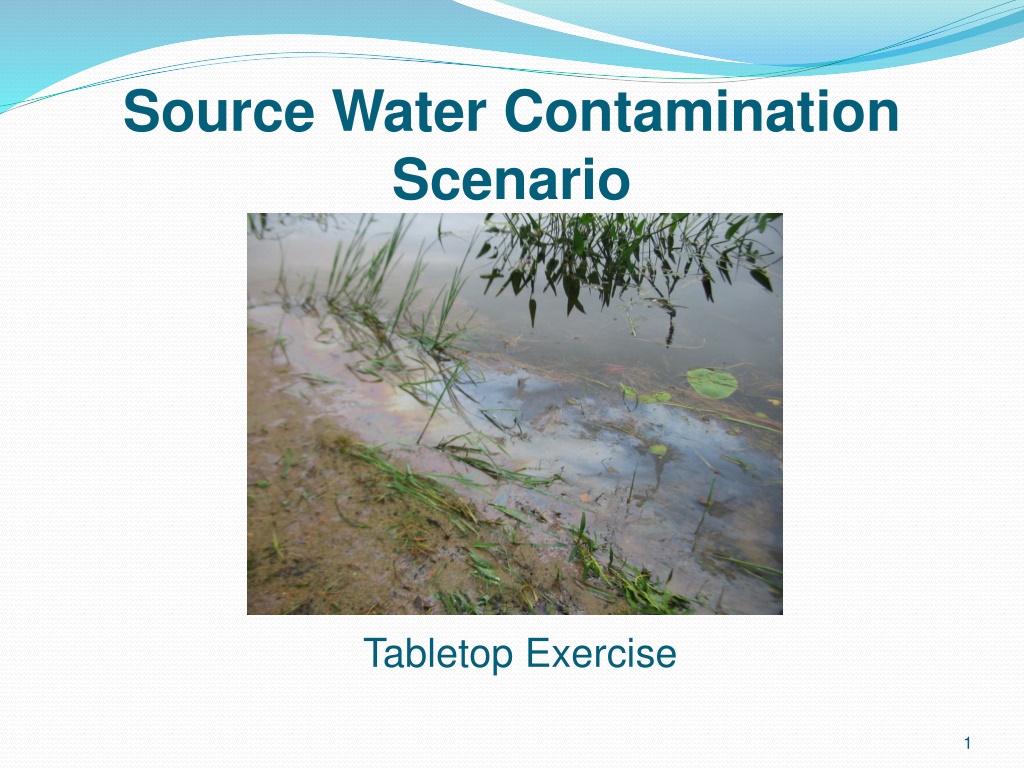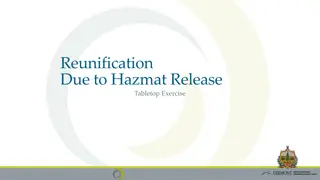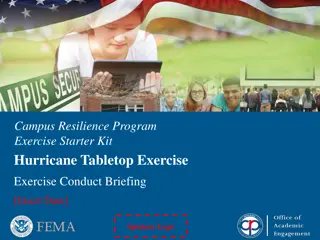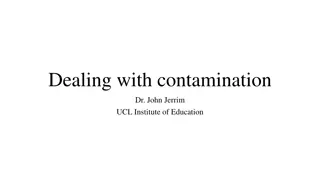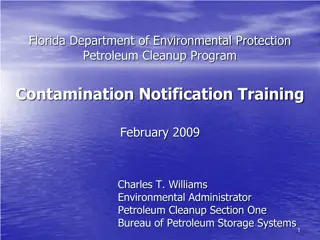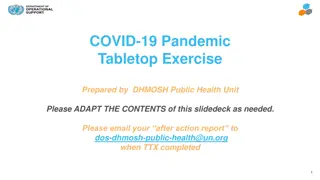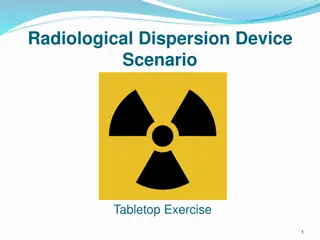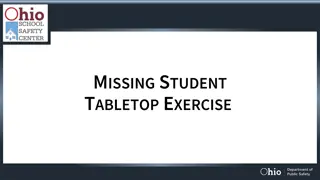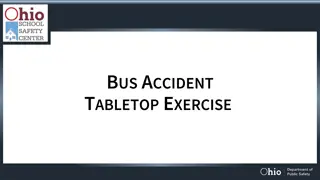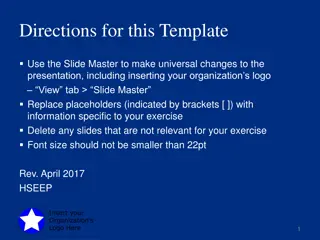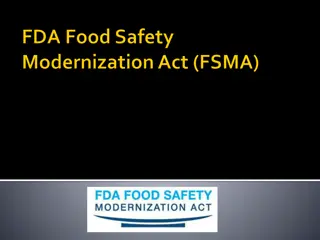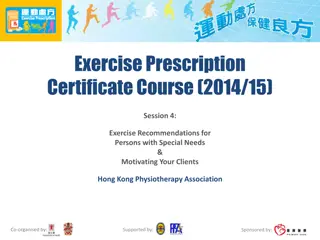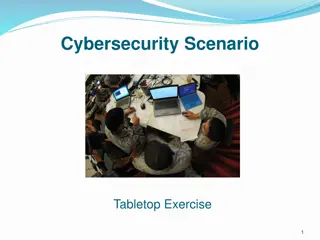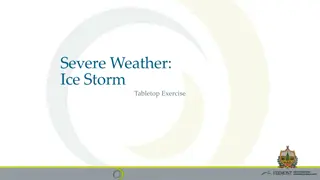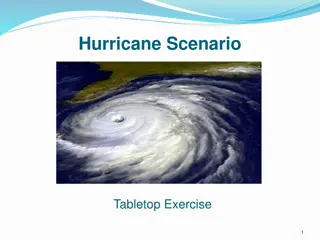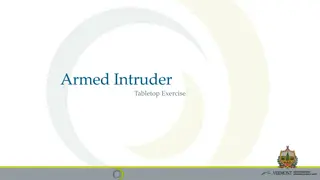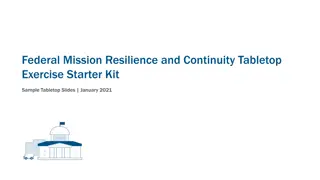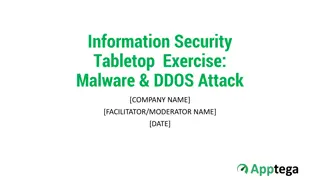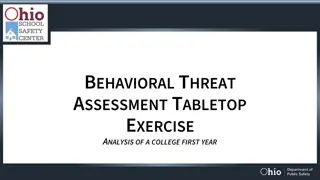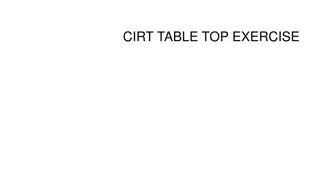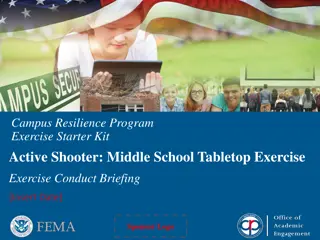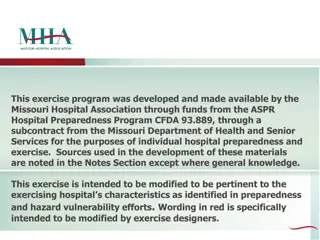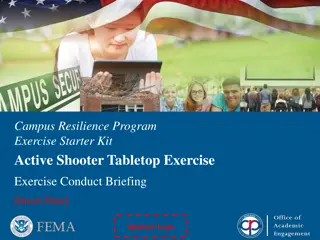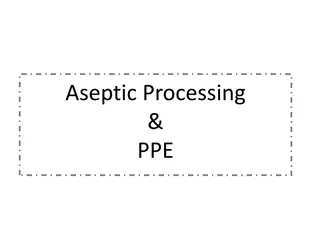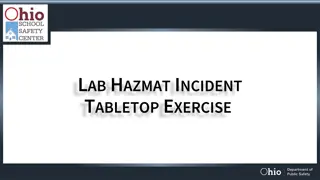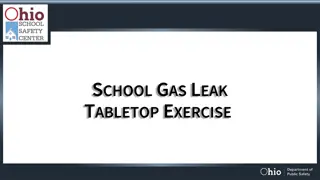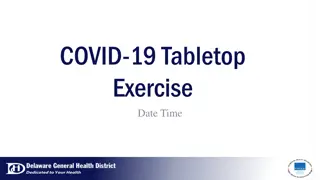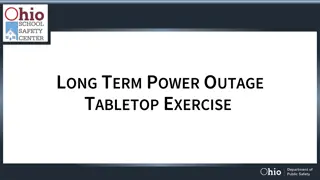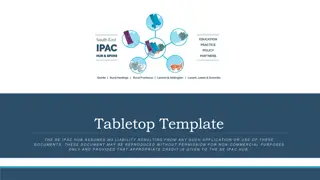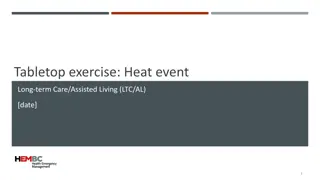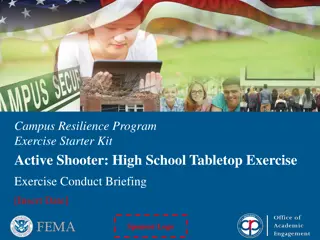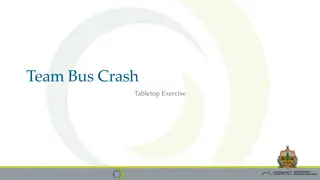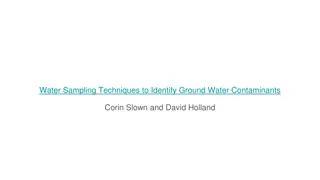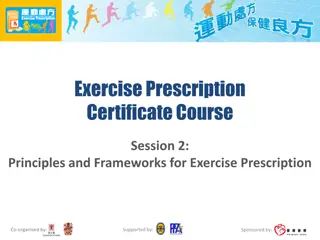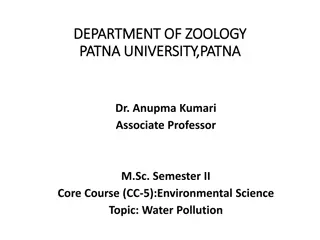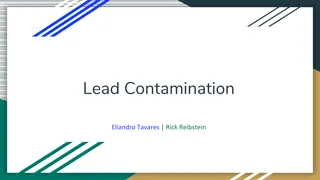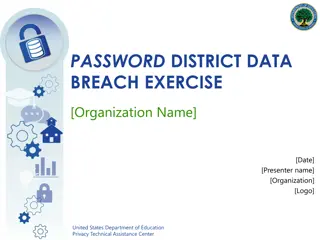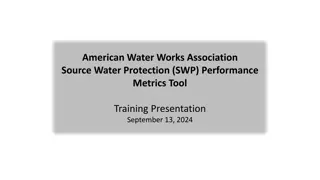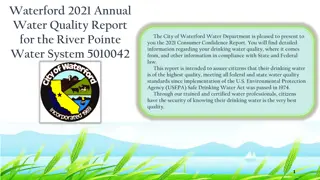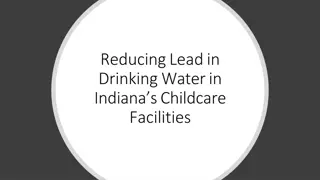Source Water Contamination Tabletop Exercise Overview
This tabletop exercise focuses on enhancing readiness for emergencies related to source water contamination incidents. Participants engage in discussions, review scenarios, and practice response skills in a controlled environment. The exercise aims to assess response plans, improve individual performance, and foster collaboration among response agencies.
Download Presentation

Please find below an Image/Link to download the presentation.
The content on the website is provided AS IS for your information and personal use only. It may not be sold, licensed, or shared on other websites without obtaining consent from the author. Download presentation by click this link. If you encounter any issues during the download, it is possible that the publisher has removed the file from their server.
E N D
Presentation Transcript
Source Water Contamination Scenario Tabletop Exercise 1
Tabletop Exercise Welcome and introductions Discuss agenda for the day Review administrative details Start the exercise 2
Welcome and Introductions Name Organization Emergency response experience 3
Agenda Review exercise materials and rules Review scenario(s) Break Facilitated discussion period Action planning session ( hot wash ) Review and conclusion Closing comments 4
Administrative Details Location of emergency exits Location of restrooms Cell phone and pager management Logging your time to fulfill training requirements Sign-in sheet and participant evaluation form 5
Exercise Benefits: Increase readiness in the event of an actual emergency Provide a means to assess effectiveness of response plans and response capabilities Serve as a training tool for response personnel and their involvement with other response agencies Provide an opportunity to practice skills and improve individual performance in a non- threatening environment 6
Exercise Benefits: (cont.) Require participants to network with each other and pre-plan decisions on resources Identify planning conflicts or gaps Identify resource needs and opportunities for sharing of resources Clarify internal and external roles and responsibilities 7
Exercise Objectives: At the conclusion of this exercise, participants should be able to do the following: Define or refine participants roles and responsibilities for managing the consequences of a source water contamination incident, which should be reflected in their plans, policies, procedures and other preparedness elements currently in place or under development Build relationships between utilities and stakeholders 8
Exercise Objectives: (cont.) Determine neighboring utility water infrastructure capabilities and needs Identify other needed enhancements related to training and exercises and other preparedness elements currently in place or under development This session will not be a success unless you as a participant go back to your office and follow through 9
Roles and Responsibilities: Players respond to the situation presented based on expert knowledge of response procedures, current plans and procedures and insights derived from training and experience Observers observe the exercise but do not participate in the facilitated discussion period Facilitators lead the exercise by presenting the scenario narrative and facilitating the discussion period and hot wash (Action planning session or review session) Evaluators monitor the exercise, track accomplishments according to objectives and may ask questions 10
Exercise Rules: This exercise will be held in an open, low-stress no- fault environment varying viewpoints, even disagreements, are expected Respond to the scenario using your knowledge of current plans and capabilities (i.e., you may use only existing assets) and insights derived from your training Decisions are not precedent setting and may not reflect your organization s final position on a given issue this exercise is an opportunity to discuss and present multiple options and possible solutions 11
Exercise Rules: (cont.) Issue identification is not as valuable as suggestions and recommended actions that could improve [prevention, protection, mitigation, response or recovery] efforts problem-solving efforts should be the focus Assume there will be cooperation and support from other responders and agencies The basis for discussion consists of the scenario narrative and modules, your experience, your understanding of your Emergency Response Plan (ERP), your intuition and other utility resources included as part of this material or that you brought with you Treat the scenario as if it will affect your area 12
Action Planning Session: Following the facilitated discussion period, the facilitator will lead an Action Planning Session, also known as a hot wash Participants are encouraged to identify, discuss and prioritize next steps, actions, tasks and other follow-up activities Identify additional collaborators if needed Schedule a follow-up meeting 13
Source Water Contamination Scenario 14
Background It is late summer, and the region is experiencing moderate drought conditions The drinking water utility relies on the local river as its source water there is a small back up reservoir, but its levels are lower than usual due to drought The river is bordered on one side by conservation land and on the other side by a large highway The highway serves as a major thoroughfare for transportation of oil and other materials 15
Module 1 August 24 Upstream Contamination Occurs 16
Module 1 August 24,0300 hrs A tank truck driver falls asleep and crashes his truck, rolling from the road into a ditch The truck s tanker continues to roll, and comes to a stop near the river s shoreline The driver survives the impact but remains unconscious There are no witnesses Forty-five minutes later, a police officer notices the truck cab in the ditch she calls for emergency medical services, but remains with the driver rather than investigating the surroundings 17
Module 1 August 24,0300 hrs (cont.) Medical staff attend to the driver while police and fire personnel assess the scene of the accident the tanker seems to be spilling its contents into the river Operators for the city s drinking water plant are waking up and heading to work The lead operator hears news of the crash and spill on the local AM radio station as he drives to work When he arrives at the plant, the night shift operator tells him that the state environmental agency called about a spill of an unknown substance upstream of the plant s intake 18
Key Issues Module 1 The drinking water utility has one intake Water treatment consists of coagulation, flocculation, sedimentation, filtration and disinfection in addition, softening, pH adjustment and fluoridation are also performed A sample of the leaking substance is collected, but it will take some time before decisive analytical results are reported 19
Key Issues Module 1 (cont.) The truck s manifest has not been located First responders noted that the spilled liquid smelled like gasoline or another petroleum product, and initial screening testing performed by fire hazmat personnel indicate petroleum as well 20
Module 2 August 24 Contamination Nears Drinking Water Intake 21
Module 2 August 24,0900 hrs A visible, expanding sheen now coats the width of the river directly downstream of the crash site EPA and the state environmental agency are assessing the situation The leak is composed of an unknown quantity of number 2 fuel oil (a distillate home heating oil) The U.S. Army Corps of Engineers (USACE) conducts surveillance by helicopter to assess the full extent of the sheen and the speed at which it is moving down the river 22
Module 2 August 24,0900 hrs (cont.) Based on their observations and knowledge of oil spill management, the USACE calculates the sheen will arrive at the city s intake in approximately 8 hours The utility decides that protective actions should be taken, but due to low reservoir levels and high summer demands, they will wait to shut the city s intake until the sheen gets closer 23
Key Issues Module 2 The utility owns several inflatable booms that can protect intake pipes from contaminants that are less dense than water Based on a river time of travel model maintained by local emergency management, the contaminant is expected to arrive at the city s intake at 1700 hours Predictions of contaminant arrival time are inexact and may change depending on weather conditions 24
Module 3 August 24 Contamination Reaches Drinking Water Intake 25
Module 3 August 24,1400 hrs The wind s direction shifts and its strength increases The higher wind speed causes the sheen to move more quickly toward the intake The sheen is now predicted to arrive within the hour, not 1700 Utility and local emergency management agency staff race to boom off the intake Utility employees rush to turn off the intake s pump, but communication issues cause a delay in shutdown 26
Key Issues Module 3 Utility staff estimates that in the time before pump shut down, about 10,000 gallons of contaminated water entered the intake The capacity of the existing treatment system to treat petroleum contamination is unknown The city may now have to rely solely on water in storage until it can be determined how treatable the contaminated water is Decontamination of parts of the water treatment plant may be necessary 27
Action Planning Session Post-Exercise Hot Wash 28
Review of Exercise Objectives Explore and address cybersecurity challenges Define or refine participants roles and responsibilities for managing the consequences of a cybersecurity incident, which should be reflected in their plans, policies and procedures and other preparedness elements currently in place or under development Build relationships between utilities and stakeholders Increase awareness of the damage that can be caused by a cybersecurity incident on a business or control system Identify other needed enhancements related to training and exercises and other preparedness elements currently in place or under development 29
Conclusion Please turn in your notes from the Action Planning Session, your participant evaluation form and any additional comments you wish to share This information will be used to develop an After Action Report and Improvement Plan 30
Closing Remarks Thank you for participating 31
